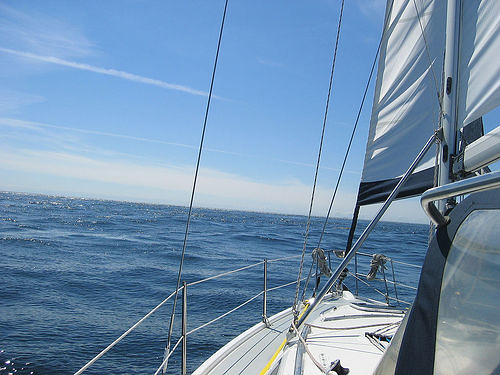At 2 a.m. this morning, after a long 4-day sail from Newport, Oregon, we finally pulled our boat into Elliott Bay Marina. I had never been out on the open water and it was a bit unnerving. Not that the weather or sea conditions were that bad, I just have a huge fear of water. I love sailing. I love to swim. And if I can see the bottom, I'll snorkel. I've even been scuba diving once.
I respect the ocean, and long ago we made a deal that basically went like this:
ME: "Ocean, you're pretty and all, but sometimes you can be really dark and mean, so I think it's best if I just hang out with Land more."
OCEAN: "That's cool. I got lots of friends."
ME: "Occasionally though, when you're in a good mood and all clear and blue, I'd like to take a dip."
OCEAN: "That would be nice. And in return, I promise not to swallow you up and spit you out."
ME: "Are those your fingers crossed behind you?"
OCEAN: <smirk>
So the short of it is I tend to steer clear, as apparently I am the only one willing to keep my end of the deal. But I have to say, I think I fared pretty well on this particular sail, despite my old friend's best efforts at scaring the bejesus out of me during our night sailing. She kept the winds at about 20 knots (not too bad), but kept flinging frequent large waves at us so that we'd smack down, the mast and rigging clanging and shaking violently.
Barnaby looks at me when my face goes sheet white and says, "Don't worry, we are not going down. This is nothing." Yeah, that's what they said about the Titanic, I thought, white knuckling the rail.

Since it was too difficult most times to go down to the galley and prepare a meal, our diet for 3 of the 4 days consisted mainly of Cheez-Its, string cheese, and Pria bars. When we entered the glassy smooth waters of the Straight of Juan de Fuca (between Canada and the U.S.) I was finally able to cook us a nice hot meal. I sautéed chicken with lots of ginger (ginger is great for seasickness and aching bellies), broccoli, and Trader Joe's Thai Coconut Lime Rice. The rice was precooked and vacuum sealed, sous-vide style (pronounced su-veed), in plastic bags.
That's when the light bulb went off. All meals on the boat should be sous-vide style!
Sous-vide, French for "under vacuum" or, according to my translation, "how to cook on the rolling high seas without vomiting in the sink," is a technique that involves cooking food sealed in airtight plastic bags over low heat for a long period of time, maintaining the integrity of the ingredients. But it can easily be done quickly if the food is pre-cooked, then sealed like the yummy Trader Joe's rice. Perfect for sailing: keep a pot of water on the stove (which rocks with the waves so nothing will spill - brilliant!), turn the heat on, pop the food in and let it boil for a few minutes, slice bag open and voila! you have a nice hot meal.
This type of cooking is not only good for boating and camping, but for delicious meals at home. Another great way to save those left-overs.
We'll be testing some sous-vide recipes and will share our favorites with you soon!
Photo: Our beautiful boat, Miss Eulie, a Hunter 356, on her way from San Francisco back to the Puget Sound waters she loves the most.











Comments
August 6, 2008
Sous vide experiments are fun. I haven't done it in awhile, but I have written about some of the dishes I've made on my blog.
http://www.inuyaki.com/archives/tag/sous-vide
There's a super-long, 4-year-old thread about sous vide on egullet.org that you might want to check out too. It's probably the best sous vide resource on the web.
http://forums.egullet.org/index.php?showtopic=116617
And this page consolidates that thread into something quick and easy to read:
http://amath.colorado.edu/~baldwind/sous-vide.html
Have fun experimenting! :-)
September 5, 2008
The Wall Street Journal ran an article (SAT/SUN 31 AUG08) that explained the Sous Vide process. Thus enlightened, I immediately thought both of past desert backpacking/climbing trips using "heat & eat" ready to eat packaged foods as well as my brother in law's experiments with vacuum sealing foods for use on his boat (a Catalina 320).
The big issue with either application though is Botulism. As the WSJ article points out, oxygen-free vacuum sealed foods are perfect incubators for anaerobic bacteria. Worse, the potentially deadly bacteria don't appreciably alter the taste or smell of the food, so detection is difficult. So the WSJ article goes on to say that New York City even put a temporary moratorium on sous vide prepared foods. In defense of the home vacuum sealer however, is the fact that they don't produce a 100% oxygen free environment in the bag, and there apparently have been no illnesses from any foods cooked sous vide.
So that all said, experiment away - just very carefully!
September 6, 2008
Thanks Arnold and Mike for the information! We err on the side of caution and always refrigerate our sous vide packets.
Thomas Keller and Harold McGee have a book coming out soon on sous vide. http://www.amazon.com/Under-Pressure-Cooking-Sous-Vide/dp/1579653510 Should be a very interesting read!